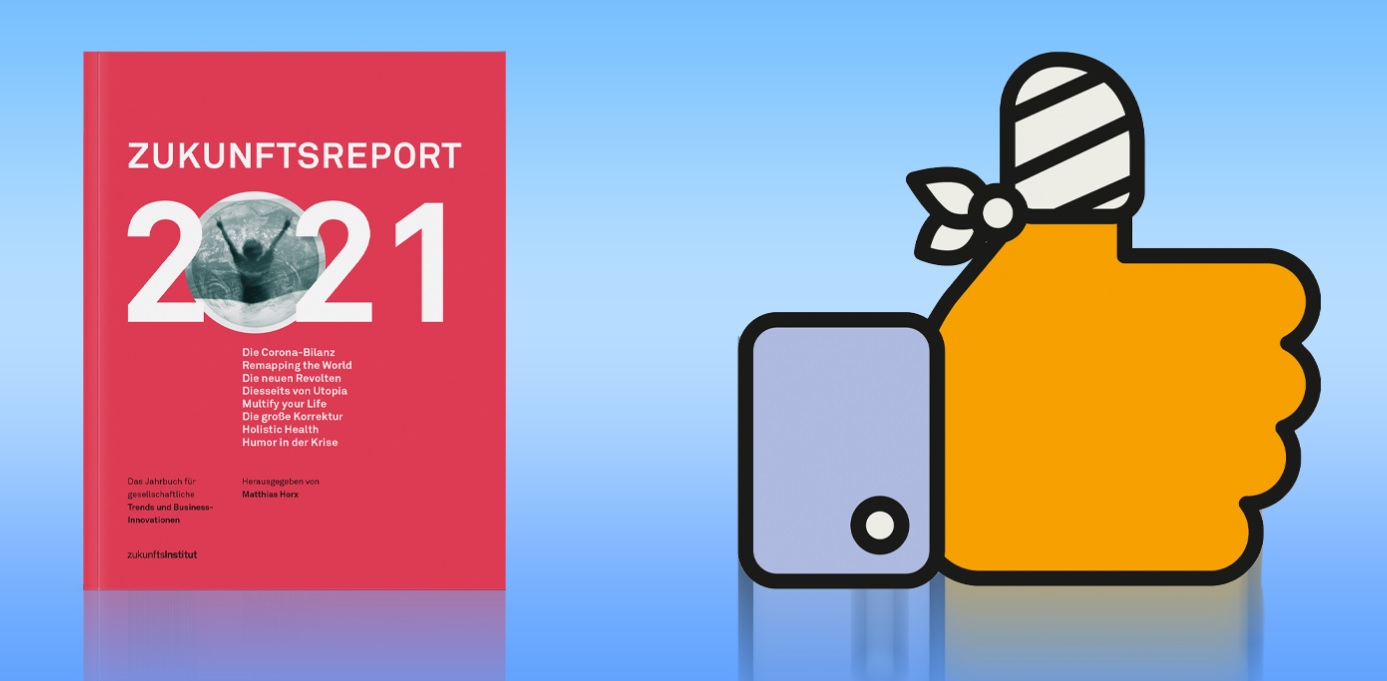At the end of the year, the Future Report of the Frankfurt Future Institute is one of my must-reads. The experts around Matthias Horx see 2021 as “the year of decision” in which a new (dis)order is supposed to emerge.

The Corona crisis will most certainly go down in history and at the same time also rewrite our future. Many changes that had already become apparent over the last few years are already part of our common reality after a few months. For example, the topic of mindfulness – and that in both analog and digital contexts. In most countries, the crisis did not divide society, but rather the social became denser and more visible, in Horx’s view. “Epidemics, in particular, have always produced spurts of modernization.”
Viable business models and sustainable product innovations
Even after a broadly available vaccine, we won’t return to the familiar, “old normal” – and that’s a good thing. Because with or without the crisis, it was clear that we were living beyond our means. A quick look at our personal resource consumption illustrates the problem. According to Horx, it’s no coincidence that overheated industries were hit particularly hard by the pandemic – air travel, mass tourism, the automotive industry, factory farming. These are all industries characterized by rapid growth and oversaturation.
Crises would put an end to market excesses and lead to a holistic approach. In the future, it will not be enough to focus solely on efficiency – this also applies to the printing industry. For the future, we need viable business models and sustainable product innovations.
New plans for the future
Maps have always given people a sense of security and order. In 1541, cartographer Gerhard Mercator solved the dilemma of not being able to represent a round body on a two-dimensional surface by geometrically constructing a cylinder around a sphere. However, this loses the proportions and distorts the view of our world.
Singapore-based “data geographer” Parag Khanna has been trying for many years to create a different kind of cartography that can be used to represent connections. The earth is not surveyed as a collection of land masses or areas but is viewed as a network. There are many interesting maps in the Future Report that open-up a new perspective: true size ratios of countries, world population maps, terrestrial cables of the online global network, the new world order with new alliances and conflicts, and the map of human prosperity to renewable strategies, and many more. “The way we map the world also weights it. Worldviews shape our attitudes, expectations, perceptions. And thus, also shape our actions,” Horx emphasizes.
An immune system against hate on the web
In recent years, there has already been a veritable boom in infographics. Numerous projects on the Internet and in exclusive illustrated books cast a spell over us and convey unusual proportions and unknown relationships at a glance. Two details from the “post-Corona trend map” that will also become apparent in the development of the printing industry: digitization is being driven forward, but at the same time a renaissance of analog cultural techniques is emerging, and this includes books and magazines, for example. Globalization is weakening, while the longing for home and regional roots is increasing, and thus purchasing behavior will also change.
There is a broad consensus, at least among scientists, about the destructive potential of social media. In the course of the pandemic, the “big socials” showed their own colors for the first time by proactively intervening against fake news. Author Anja Kirig is convinced that an evolution of social media was initiated in connection with the pandemic: Slowly, she says, an immune system is developing against anger, hate and fear on the Internet. Tomorrow’s social media mindset focuses on collaboration and connectivity rather than pure self-expression.
From touchpoints to trustpoints
Meaningfulness and resonance are becoming the new currency for brands. Against this backdrop, brands must increasingly see themselves as units of meaning that achieve an effect not only in the market, but also in society. In the future, it will therefore no longer be primarily about products and prices, but about creating meaning, integrity and responsibility. Sustainability alone is not enough. Credibility, transparency and a clear set of values are required here. Thus, “touchpoints” become “trustpoints”. For corporate action, this means that if you want to sell fair products, you also have to create fair conditions for all stakeholders.
A brand that credibly presents itself as a collective idea, as a tangible concern, no longer tells a vision – it is one. In the future, brands must stand up for their values authentically, transparently and consistently.
We live in “plastic times”
The reconstruction after Corona should be seen as a major correction: It follows the maxim “quality instead of quantity” – which should lead to an increase in quality of life. The historian and philosopher Gershom Scholem refers to those moments in history when many things can suddenly change as “plastic times” that change the course of the world. This is an opportunity presented by the Corona Crisis, and we should all seize it!
Yours
Knud Wassermann, Editor-in-Chief “Graphische Revue”
This text is reproduced with kind permission of Muller Martini, you can read the original article first published here.
